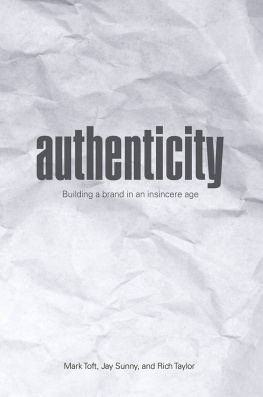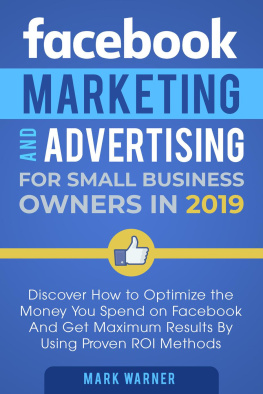Authenticity
Authenticity
BUILDING A BRAND
IN AN INSINCERE AGE
Mark Toft, Jay Sunny, and Rich Taylor

Copyright 2020 by Mark Toft, Jay Sunny, and Rich Taylor
All rights reserved. No part of this publication may be reproduced, stored in a retrieval system, or transmitted, in any form or by any means, electronic, mechanical, photocopying, recording, or otherwise, except for the inclusion of brief quotations in a review, without prior permission in writing from the publisher.
Library of Congress Cataloging-in-Publication Data
Names: Toft, Mark, author. | Sunny, Jay, author. | Taylor, Rich, author.
Title: Authenticity : building a brand in an insincere age / Mark Toft, Jay Sunny, and Rich Taylor.
Description: Santa Barbara, California : Praeger, an imprint of ABC-CLIO, LLC, [2020] | Includes bibliographical references and index.
Identifiers: LCCN 2019029862 (print) | LCCN 2019029863 (ebook) | ISBN 9781440873201 (cloth) | ISBN 9781440873218 (ebook)
Subjects: LCSH: Branding (Marketing) | Advertising. | Authenticity (Philosophy)
Classification: LCC HF5415.1255 .T65 2020 (print) | LCC HF5415.1255 (ebook) | DDC 658.8/27dc23
LC record available at https://lccn.loc.gov/2019029862
LC ebook record available at https://lccn.loc.gov/2019029863
ISBN: 978-1-4408-7320-1 (print)
978-1-4408-7321-8 (ebook)
24 23 22 21 20 1 2 3 4 5
This book is also available as an eBook.
Praeger
An Imprint of ABC-CLIO, LLC
ABC-CLIO, LLC
147 Castilian Drive
Santa Barbara, California 93117
www.abc-clio.com
This book is printed on acid-free paper 
Manufactured in the United States of America
Contents
Acknowledgments
The advertising industry is populated with con artists and boozers. At least thats what the conventional wisdom says. While weve encountered some hucksters in this business, weve met far more people who are thoughtful, ethical, and genuine.
Were thankful for all of the people who have influenced us and helped shape how we approach branding and advertisingpeople like Chris Miller, Derek Webster, Officer Sarah Delaney, Brian Distefano, Carla Mae Streeter, Brian Braman, Steve Kline, Father Stewart, Mike Wise, Sven Kahler, Markus Trnkle, Rocker Dsir Heimlicher, Christoph Hess and Denis Bernhardt. Were grateful to our agent, Sheree Bykovsky, for finding a good home for this book with Praegerand to Kevin Downing, our editor, for seeing this books potential and helping us realize it.
Were grateful for the love and support of our wives and children. Beth, Joanna, and Caroline Toft. Rita, Julia, and Justine Sunny. Beth, Jack, Sarah, and Kate Taylor. Were grateful for our parents and siblingsfor the life of Karen Pope and for Tom and Carol, and Eric and David Toft. For James and Ranae, Jeff, Robin and Jim Sunny. And finally, were grateful for our extended families, Beshears, Popes, Eichers, and Siggs, across America and Switzerland. Weve been blessed with more than we deserve.
This is not an introduction
Introductions are like the warm-up acts that take the stage before the bands youve paid to see. Or the conference speaker who loses the goodwill of the audience by opening with, How are we doing tonight? I want you to say, Great like you mean it! On the count of three now, how are we doing tonight?
If youre like many readers, you skip introductions. On several occasions weve gone back and read introductions and thought, This is actually pretty good. They should have put this somewhere in the book where more people would actually read it. Works of fiction dont bother with introductions. They get right to the story.
Well try to do the same by getting to the point: we have several things to express in this book that can help you and your business. Though each chapter contains something of value, not every chapter will be of equal value to you and your situation. We encourage you to roam around. Each chapter is quick and memorable and concludes with a key point. The main points we want to make are packaged in what we call micro-stories or aphorisms that are entertaining and, therefore, easier to remember and retell. Think of this book as a buffet with stations that you can sample, skip, and return to later. This way you can find the pieces of wisdom that will be the most helpful to solving the challenges you face at this moment.
Weve distilled the biggest lessons weve learned while working at branding and advertising firms in Chicago, Detroit, Zurich, Paris, Boston, and now Denver, where Narrator Group is headquartered. These lessons have helped transform the businesses and lives of our clients. We have long wanted to share these principles with a larger audience, so we decided to write this book.
This is a new kind of business book that bridges the gap between management and marketing books because it addresses two issues that are fundamental to both facets of business: 1) how to motivate employees and move prospects and 2) how to think about and talk about your company, products, and services.
This book is for anyone who has ever struggled to make their business sound interestingwho feels they could be more inspiring than their lengthy mission statement. Much of the advice in this book is about something more primary than operations or logistics: messaging. Or, if you prefer, story.
This book is for people who grind their teeth when reading business jargonwho rightly feel that they shouldnt have to leave their desire for a compelling narrative at Netflix or at the fiction rack of the bookstore. This book tries to live up to the observation of Alan Kay, a former vice president at Disney: Scratch the surface in a typical boardroom, and were all just cavemen, hungry for a wise man to tell us stories.
This book is dedicated to the truth. Branding and advertising in fact do work and can help businesses grow. Its not necessarily the best product or service that wins. Often its the company that tells the better story.
The ideas youll find in this book offer new ways of looking at branding and marketing. Like any business book worth its salt, it provides insights and anecdotes that can be applied to other areas of life. This book is equal parts provocation and exhortation. You shouldnt have to be in business or even interested in branding to get something of value from reading it. We confess that this is a bit of an introduction, but at least it was brief and less interruptive than a warm-up band.
PART I
Setting the Stage
The best definitions of branding and advertising youll find
We struggle to talk about ourselves. Its a lament we hear a lot. And its exactly the kind of problem branding should solve. Surprisingly few companies make their brand easy to understand, Jeremy Miller writes in the book Sticky Branding. They struggle to explain their business clearly.
Too often the discipline broadly defined as branding deepens rather than resolves this challenge. A president at a large independent branding firm once mused aloud to us about the meaning of a brand promise. I wish someone would clarify what a brand promise is, he said. I still get confused about how its different from a brand position.
It was like hearing the emperor wish his tailors had made him real clothes. The truth is that a lot of the things that pass for branding are thickening agents meant to make businesses feel theyve paid for something substantial. As Rodney Dangerfields character Thornton Mellon said in Back to School (1986) when taking the measure of a paper his Tall & Fat store employees had written for him, Its too light. Feels like a C. Bulk it up and add some multi-colored graphs.
Next page











